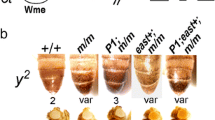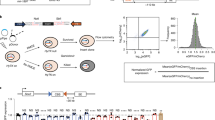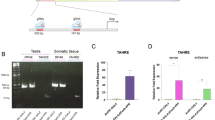Abstract
Transvection is a phenomenon of interallelic communication in which enhancers can activate a specific promoter located on a homologous chromosome. Insulators play a significant role in ensuring functional interactions between enhancers and promoters. In the presented work, we created a model where two or three copies of the insulator are located next to enhancers and promoters localized on homologous chromosomes. Using the Su(Hw) insulator as a model, we showed that the functional interaction between a pair of insulators promotes enhancer–promoter trans-interactions. The interaction between the three insulators, on the contrary, can lead to the formation of chromatin loops that sterically hinder the full enhancer–promoter interaction. The results of the work suggest the participation of insulators in the regulation of homologous chromosome pairing and in communication between distant genomic loci.



Similar content being viewed by others
REFERENCES
Hafner, A. and Boettiger, A., The spatial organization of transcriptional control, Nat. Rev. Genet., 2023, vol. 24, no. 1, pp. 53–68. https://doi.org/10.1038/s41576-022-00526-0
Kyrchanova, O., Sokolov, V., and Georgiev, P., Mechanisms of interaction between enhancers and promoters in three Drosophila model systems, Int. J. Mol. Sci., 2023, vol. 24, no. 3, p. 2855. https://doi.org/10.3390/ijms24032855
Cavalheiro, G.R., Pollex, T., and Furlong, E.E., To loop or not to loop: what is the role of TADs in enhancer function and gene regulation?, Curr. Opin. Genet. Dev., 2021, vol. 67, pp. 119–129. https://doi.org/10.1016/j.gde.2020.12.015
Geyer, P.K. and Corces, V.G., DNA position-specific repression of transcription by a Drosophila zinc finger protein, Genes Dev., 1992, vol. 6, no. 10, pp. 1865–1873.
Baxley, R.M., Bullard, J.D., Klein, M.W., et al., Deciphering the DNA code for the function of the Droso-phila polydactyl zinc finger protein suppressor of hairy-wing, Nucleic Acids Res., 2017, vol. 45, no. 8, pp. 4463–4478. https://doi.org/10.1093/nar/gkx040
Melnikova, L., Kostyuchenko, M., Molodina, V., et al., Interactions between BTB domain of CP190 and two adjacent regions in Su(Hw) are required for the insulator complex formation, Chromosoma, 2018, vol. 127, no. 1, pp. 59–71. https://doi.org/10.1007/s00412-017-0645-6
Golovnin, A., Melnikova, L., and Babosha, V., The N-terminal part of Drosophila CP190 is a platform for interaction with multiple architectural proteins, Int. J. Mol. Sci., 2023, vol. 24, no. 21, p. 15917. https://doi.org/10.3390/ijms242115917
Bartkuhn, M., Straub, T., Herold, M., et al., Active promoters and insulators are marked by the centrosomal protein 190, EMBO J., 2009, vol. 28, no. 7, pp. 877–888. https://doi.org/10.1038/emboj.2009.34
Gause, M., Morcillo, P., and Dorsett, D., Insulation of enhancer–promoter communication by a gypsy transposon insert in the Drosophila cut gene: cooperation between suppressor of hairy-wing and modifier of mdg4 proteins, Mol. Cell Biol., 2001, vol. 21, no. 14, pp. 4807–4817. https://doi.org/10.1128/MCB.21.14.4807-4817.2001
Melnikova, L., Kostyuchenko, M., Molodina, V., et al., Multiple interactions are involved in a highly specific association of the Mod(mdg4)-67.2 isoform with the Su(Hw) sites in Drosophila, Open Biol., 2017, vol. 7, no. 10, p. 170150. https://doi.org/10.1098/rsob.170150
Stogios, P.J., Downs, G.S., Jauhal, J.J.S., et al., Sequence and structural analysis of BTB domain proteins, Genome Biol., 2005, vol. 6, no. 10, p. R82. https://doi.org/10.1186/gb-2005-6-10-r82
Savitskaya E., Melnikova L., Kostuchenko M., et al., Study of long-distance functional interactions between Su(Hw) insulators that can regulate enhancer–promoter communication in Drosophila melanogaster, Mol. Cell Biol., 2006, vol. 26, no. 3, pp. 754–761. https://doi.org/10.1128/MCB.26.3.754-761.2006
Duncan, I.W., Transvection effects in Drosophila, Annu. Rev. Genet., 2002, vol. 36, pp. 521–556. https://doi.org/10.1146/annurev.genet.36.060402.100441
Kravchenko, E., Savitskaya, E., Kravchuk, O., et al., Pairing between gypsy insulators facilitates the enhancer action in trans throughout the Drosophila genome, Mol. Cell Biol., 2005, vol. 25, no. 21, pp. 9283–9291. https://doi.org/10.1128/MCB.25.21.9283-9291.2005
Geyer, P.K. and Corces, V.G., Separate regulatory elements are responsible for the complex pattern of tissue-specific and developmental transcription of the yellow locus in Drosophila melanogaster, Genes Dev., 1987, vol. 1, no. 9, pp. 996–1004. https://doi.org/10.1101/gad.1.9.996
Qian, S., Varjavand, B., and Pirrotta, V., Molecular analysis of the zeste–white interaction reveals a promoter-proximal element essential for distant enhancer–promoter communication, Genetics, 1992, vol. 131, no. 1, pp. 79–90. https://doi.org/10.1093/genetics/131.1.79
Geyer, P.K., Spana, C., and Corces, V.G., On the molecular mechanism of gypsy-induced mutations at the yellow locus of Drosophila melanogaster, EMBO J., 1986, vol. 5, no. 10, pp. 2657–2662. https://doi.org/10.1002/j.1460-2075.1986.tb04548.x
Scott, K.C., Taubman, A.D., and Geyer, P.K., Enhancer blocking by the Drosophila gypsy insulator depends upon insulator anatomy and enhancer strength, Genetics, 1999, vol. 153, no. 2, pp. 787–798. https://doi.org/10.1093/genetics/153.2.787
Bischof, J., Maeda, R.K., Hediger, M., et al., An optimized transgenesis system for Drosophila using germ-line-specific phiC31 integrases, Proc. Natl. Acad. Sci. U. S. A., 2007, vol. 104, no. 9, pp. 3312–3317. https://doi.org/10.1073/pnas.0611511104
Baxley, R.M., Soshnev, A.A., Koryakov, D.E., et al., The role of the Suppressor of Hairy-wing insulator protein in Drosophila oogenesis, Dev. Biol., 2011, vol. 356, no. 2, pp. 398–410. https://doi.org/10.1016/j.ydbio.2011.05.666
Funding
The study was supported by the Russian Science Foundation (project no. 22-24-00719).
Author information
Authors and Affiliations
Corresponding author
Ethics declarations
CONFLICT OF INTEREST
The authors of this work declare that they have no conflicts of interest.
ETHICS APPROVAL AND CONSENT TO PARTICIPATE
The requirements of the bioethical committee do not apply to the subject of the study; human research was not conducted.
Additional information
Translated by M. Batrukova
Publisher’s Note.
Pleiades Publishing remains neutral with regard to jurisdictional claims in published maps and institutional affiliations.
Rights and permissions
About this article
Cite this article
Melnikova, L.S., Molodina, V.V., Georgiev, P.G. et al. Impact of Interactions between Su(Hw)-Dependent Insulators on the Transvection Effect in Drosophila melanogaster. Dokl Biochem Biophys (2024). https://doi.org/10.1134/S1607672924700820
Received:
Revised:
Accepted:
Published:
DOI: https://doi.org/10.1134/S1607672924700820




